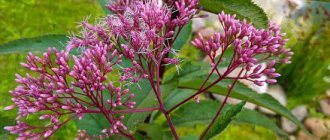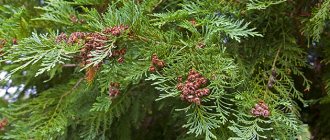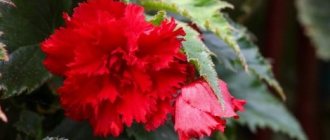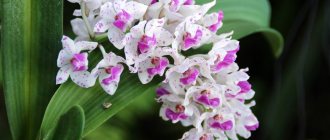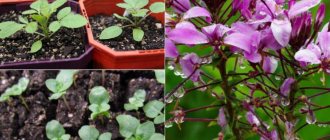Author: Elena N. https://floristics.info/ru/index.php?option=com_contact&view=contact&id=19 Category: Garden plants Published: February 24, 2019Last edits: January 13, 2021
- Spring care
- How and when to collect seeds
- Early weigela, or pleasant weigela (Weigela praecox)
Among ornamental shrubs there are not many that can bloom twice a season. But weigela is just such a shrub. Another advantage of the culture is its winter hardiness: even after severe frosts, weigela quickly recovers. As for decorativeness, weigela is simply charming: during flowering it is covered with fragrant flowers. pink, white, yellow or red.
We offer you material carefully selected by our specialists, from which you can learn:
- how to plant weigela;
- how to care for this plant before and after flowering;
- when and how to trim weigela;
- how to prepare a plant for wintering.
Botanical description of weigela shrub
Weigela is a deciduous shrub. The shoots are erect, their height is from 50 to 200 cm, but some varieties grow up to 3 meters. During growth it does not form stolons. The leaves grow according to the principle of opposite arrangement. The shape is slightly elongated, elliptical, the edges are slightly jagged. The stalk is small.
Depending on the type and growing conditions, the flowers can be single or collected in inflorescences of 2-6 buds. The color can be different: white, pink, red, purple. Pedicels are moderately developed. Sometimes the calyxes grow together into a common peduncle. The flower itself has a slightly elongated shape and 5 petals. Outwardly very similar to a bell. There are also five stamens and they are smaller in size than the corolla.
After flowering, a hard box is formed on the bushes, which has a cylindrical or oval shape. Inside it, small angular-shaped seeds with winged parts ripen.
Trimming
The first time pruning of weigela is carried out in the spring - for sanitary purposes, removing branches:
- frozen;
- broken;
- with signs of illness;
- intersecting, which are capable of rubbing each other, damaging the bark;
- growing towards the inside of the crown;
- excessively thickening the bush.
In addition, in order to achieve luxurious flowering of tall varieties of weigela, it is allowed to remove the growing point from the branches of the bush in May.
The second pruning is formative, and occurs in mid-summer immediately after the completion of the first weigela flowering. It is important to emphasize that for autumn flowering, weigela grows flowers on the shoots of the current year, so formative pruning must be done before their growth begins.
Once every 3 years, formative pruning is combined with rejuvenating pruning, completely removing branches older than 3 years and shortening all remaining ones by 1/3 or even half the length. This technique may seem harsh, but weigela is one of the fastest regenerating shrubs. But there is no autumn pruning of weigela, even sanitary pruning - it overwinters perfectly without it.
To prevent infection from entering the bush after cutting, the pruning shears (knife, scissors) should be disinfected, and the cut areas should be treated with garden varnish.
Features of weigela flowering
Weigela is loved by gardeners not only for its compactness and decorativeness, but also for the opportunity to enjoy its flowering twice a season.
The first period falls at the end of spring and beginning of summer. Under favorable conditions, flowering repeats in early September. True, there are not as many inflorescences as in summer. The buds that appear on the bushes initially have a very pale color. But in the process of blooming, the flower begins to become saturated with colors and, as a result, the color becomes bright.
The aroma is weakly expressed, it is unlikely that it can be detected in the garden, but it is quite enough for pollinating insects.
Currently, there is a wide selection of weigel colors: you can choose a bush with pink, white, yellow, red, cream and even speckled flowers.
Winter-hardy weigela varieties for the Moscow region and beyond
Thanks to the efforts of breeders, it was possible to develop varieties of weigel that winter well in the central zone of our country. Let us consider below those species and their varieties that can be used for cultivation in the Moscow region and other regions.
Please note that the flowering weigela varieties Alba, Nana Purpurea and Nana Variegata are excellent for Siberia and the Urals.
Alba
Nana Purpurea Nana Variegata
Flowering weigela or Florida (Weigela florida) + 19 varieties with photos and descriptions
Grows up to 3 meters. The shoots in two rows are covered with small hairs, and the leaf blade has pubescence along the central vein. Flowering begins at the end of May and lasts no more than three weeks. At this time, the bush is covered with pink flowers, collected in inflorescences of 3-4 pieces.
This species is represented by several varieties, consider them in the table:
| Variety | Characteristic |
| Rosea | Large bush up to 2 m high and 2.5 m wide. The flowers are large, pink, with a spicate limb, slightly dazzled with white. The leaves are light green, turning red in autumn. Blooms in June. The variety has excellent winter hardiness. |
| Candida | The bush grows up to 2-2.5 m. The flowers are large, white, collected in loose panicles. The leaves are light green. |
| Purple, red or Nana Purpurea (Nana Purpurea) | The height of the bush is 1.5 m. The crown is lush. Flowering begins no earlier than mid-June and continues until July. The flowers are an intense dark pink and the leaves have a reddish tint. Perfect if you don't have much space in the garden. |
| Alba | A low-growing bush about 50 cm in height. It blooms with white flowers that turn pink when withered. |
| Nana Variegata | It is considered the most frost-resistant weigela. Height up to 1.5 m. Leaf blades are small, green with a cream edging. The flowers are very beautiful, bell-shaped, white and pink. Blooms in June and July. |
| Pink Poppet | Dwarf bush, spherical crown. Height 0.8 m. Leaves are oblong, pointed, jagged, pleasant green in color. The flowers are soft pink. |
| Pink (Bunge) | The variety is distinguished by large pink bell flowers (4 cm in diameter). The height of the bush is 1.5 m, the crown is spreading and lush. |
| Victoria | The height of the bush does not exceed 1 meter, the leaf blades have a brownish-red tint, and the flowers are purple-red, light pink inside. |
| Alexandra | The bush grows up to 2 m. The leaves have a unique purple color and the flowers are deep pink. |
| Marjorie | Height 1.2 m. The variety is distinguished by the fact that one inflorescence can simultaneously contain flowers of white, pink and purple colors. The diameter of the flowers is 2-6 cm. It blooms in May-June. The leaves are green, drop-shaped. |
| Brigela or Brigella | The bush grows up to 2.5 meters, the shoots hang down slightly. The leaves are light green with yellowish veins. The color of the flowers is ruby. |
| Ebony and Ivory | An ornamental shrub, the height of which does not exceed 0.9 m, width - 0.9-1.2 m. The leaves have a dark purple tint and will appear black from a distance. They are especially effectively set off by the snow-white inflorescences that appear at the beginning of summer. Frost resistance down to -29 ºС. |
| Black and White or Black and White (Black and White) | A dwarf bush with a rounded crown, 0.3-0.4 m high and 0.6-0.8 m wide. The flowers are white with a carmine-red throat, bell-shaped, there are many of them. The variety blooms in June. The leaves are initially dark green and gradually become plum-purple. They contrast beautifully with the flowers. |
| Carnaval | Plant height up to 0.7 m. Flowers are white, pink and red (on one bush). Flowering occurs in June-July. |
| Naomi Campbell | Compact shrub with a dense crown up to 0.9 m high. The flowers are purple-red, the leaves are dark purple-bronze. |
| Pink Princess or Pink Princess | The height of the variety is 1.5 m. The crown is spreading. The flowers are a pleasant light pink shade. Blooms in May-June. Sometimes it blooms again in August. |
| Ruby Queen | Height up to 0.8 m. The crown is very dense and branched. The leaves are reddish or copper in early summer, gradually becoming brownish-red, but without the purple tint. In hot weather they change partly to a dark olive green color, but at the tops of the shoots new leaves still grow brownish-red. In autumn they turn shades of bronze. Bell flowers appear in June. They are dark pink in color and become darker as they bloom. |
| Wings of Fire or Wings of Fire | The height, as a rule, does not exceed 0.9 m. But by 10 years it can reach 1.2 m. The leaves in the spring are green-brown with a reddish or copper tint, in the summer they become light green, and from July they again begin to acquire purple-red shades . The flowers are pink-lilac. Flowering occurs in June-July. |
| Elvira or Elvera | The height of the bush is up to 0.9 m. The crown is dense and compact. The leaves are dark purple. The flowers are pink. The variety begins to bloom in June, but may repeat in August-September. |
Hybrid weigela (Weigela hybrida) + 3 varieties with photos and descriptions
Grows up to 1.5 meters in height. The crown is spreading. The flowering is abundant and lush, the color of the petals depends on the variety. The following varieties belong to hybrid weigela; we will also consider them in the table:
| Variety | Characteristic |
| Bristol Ruby | The variety was bred in the USA. A tall shrub that grows up to 2-3 meters. The crown is very lush. The leaf blades are bright green. Flowering begins in May or June, the petals are red with ruby edges, and there are buds with an orange core. Inflorescences abundantly cover the shoots. This variety can be used as a hedge, as the centerpiece of a flower bed, or as a colorful backdrop. Even with the arrival of autumn, the shrub retains its beautiful green foliage for a long time. |
| Red or Red Prince | Another American variety. It grows up to 1.5 meters, the shoots droop slightly, the crown is lush, the flowers are bright red. The leaves are green and beautiful. The variety can bloom twice per season (in May and August). The leaves do not fall until late autumn. Withstands frosts down to -20 °C. |
| Eva Rathke | A hybrid between Korean weigela (coraeensis) and abundantly flowering (floribunda). The bush is compact, up to 1.5 m high with a spreading crown (its diameter is up to 3 m). The leaves are light green. The bell flowers are 4 cm in diameter, blood red on the outside and lighter on the inside. Blooms in June-August. |
Early weigela (Weigela praecox) + 3 photos
This species is most often found in natural conditions in the Far East. The height of the shoots can reach 2 meters. The upper part of the leaf blade is covered with fine fluff and yellow specks, which turn creamy in the sun. Inflorescences are formed on the lateral shoots of the current year and consist of 2-3 flowers. Their color is often pink, but sometimes the throat can have a light yellow tint.
The buds begin to bloom in the last week of May, flowering lasts from 1 to 4 weeks.
Weigela suavis + 3 photos
It is a shrub up to 1.5 m high. The leaves are green, bare, pointed, pubescent on the inside, up to 6 cm long. The flowers are pink-violet or lilac-pink, pale pink inside. The species blooms from late May to June, sometimes longer. Possible re-blooming at the end of August.
Variegated weigela (Weigela variegata) + 3 photos
Bush 1.5 m tall. The flowers are pink-red, grow singly or in groups of up to 2-6 pieces. The leaves are green with white edges. It blooms in May-July, sometimes it blooms again at the end of summer.
Weigela middendorffiana + 3 photos
The height is 1-1.5 m, the shoots are erect and ascending. The flowers are large, bright yellow, 3.5-4 cm in diameter. They can be solitary, but most often they are collected in an inflorescence of 3-4 pieces. Under favorable conditions, flowering occurs twice per season. The leaves are large, light green, finely toothed, oval with a pointed tip.
New winter-hardy weigela varieties for central Russia
Breeders are constantly working on new varieties of weigela that can be grown in areas with frosty winters. For example, such new products are:
- Variety All Summer Peach. This is the most compact of all varieties of flowering weigela. It grows no more than 40 cm in length and width. The leaves are bright green, flowering occurs in May-June with peach-white tubular inflorescences. It re-blooms in August-September and is a winter-hardy variety.
- The Caricature variety, also low-growing, is intended for green borders. It has very unusual twisted thick and large leaves, similar in shape to basil leaves, with a light edging. Pink flowers appear in May-June, August-September. Winter-hardy.
Planting weigela in spring in stages
A shrub with Asian roots has long been adapted to our growing conditions, so when planting weigela it is enough to adhere to simple agrotechnical rules.
Choosing a weigela seedling
The most important step when growing weigela is to choose the right healthy and viable seedling. Today you can buy it almost anywhere – from famous nurseries to little-known online stores. Of course, it is better to buy a plant from trusted manufacturers and do it “live” in order to independently assess the condition of the bush.
When choosing, you need to pay attention to the following parameters:
- Weigela should be approximately 3 years old. If it is much smaller, it will be difficult for the plant to adapt to new conditions. But an adult weigela may not like the transplant, because she is already accustomed to her living conditions and may simply not tolerate stress.
- The root system must be closed if you plan to plant some time after purchase. If the roots are open, then the weigela will not be able to stand for a long time without soil and water. In this case, you need to prepare the bed in advance and immediately place the bush with an open root system in the ground from the nursery.
- It is worth choosing plants with healthy roots without signs of pests or damage. If you purchase seedlings with an open root system, slight drying of the roots is allowed. To prevent them from completely drying out, for example, during transportation, they are first placed in a clay mash, taken out and waited for drying.
- The shoots should not be wilted; there should be no signs of damage, cuts or lesions on their surface.
Choosing a place to plant weigela
Weigela grows well in both sun and shade. But it is worth considering that she still prefers sunny places and the brightest and most luxuriant flowering can be obtained only with a sufficient amount of light. Otherwise, the color of the leaves and petals will be pale and the crown less lush.
It is best to plant weigela in a well-lit part of the garden, protected from wind and drafts by a fence or nearby plantings.
You should not place weigela in lowlands where water drains poorly or accumulates after snow melts. If there is stagnation of moisture at the roots, there is a risk of developing various putrefactive diseases.
The best soil for weigela
Weigela grows well in loamy or super-sandy soil. It must contain humus and a little sand. In addition, when planting shrubs, it is necessary to consider a drainage system that will avoid stagnation of moisture at the roots of the plants.
Soil acidity can be neutral or slightly elevated.
Weigela planting dates
In the regions of the Central zone, you should not risk planting weigela in the fall. She will not be able to survive the winter and will die.
The best period for planting shrubs is April - early May. In the southern regions, you can start work a few weeks earlier. The main thing is that the earth warms up to +13 °C, and that night frosts do not appear in the weather forecast for the coming days. Seedlings with a closed root system can be planted at any stage of growth and even during the flowering period.
It is better to work with young seedlings before the buds swell on them.
Step-by-step instructions for planting weigela
The instructions for planting weigela are quite simple. It includes several stages:
- Soil treatment . It is advisable to pre-fertilize the place where the shrub is planted. It is better in the fall, digging up the ground along with manure, humus and compost. If this has not been done, then immediately before planting it is necessary to add organic matter and mineral fertilizers.
- Preparing the hole . The hole dug should be twice as large as the size of the rhizome with a lump of earth. The bottom of the hole must be covered with gravel or expanded clay, which will act as a drainage cushion. But if the soil is quite loose and light, then this stage can be skipped.
- Inspection and preparation of seedlings . Purchased seedlings should be carefully inspected for damage to the roots and signs of the presence of insect pests. If there are dry or rotten roots, they must be removed before planting. If weigela grows in a pot, then before placing it in the garden bed, it must be thoroughly watered. Seedlings with a closed root system are immersed in water for 4-6 hours so that the lump is saturated with water. If plants with an open root system were treated with a clay mash, then before planting all the clay from the roots must be washed off - it inhibits the normal growth and development of the plantings. Weigela takes root well and adapts to a new place without additional tricks, but if the purchased seedling causes you concern, then you can soak the roots in a special solution with the addition of a growth stimulant, for example, Kornevin.
- Landing distance . If you do not plan to make weigela part of the landscape composition, then it is recommended to plant it no closer than 2 meters from your neighbors. When creating a hedge, the distance between seedlings should be 1-1.5 m.
- Watering and mulching . The seedling is carefully placed in the hole. If the roots are open, they need to be straightened inside the hole. Next, it is covered with soil and watered. To retain water inside the soil, it is necessary to mulch the top layer of soil around the bush. For these purposes, you can take sawdust or bark.
Preparing for winter
Around the end of October - beginning of November, the weigela sheds its last leaves and is prepared for wintering. First of all, to protect the root system, the tree trunk circle is covered with earth to a height of 15–20 cm.
The branches of a young low-growing shrub are flexible and strong - they can be pressed, spread out on the ground and secured so that they do not straighten out. In mature tall plants, the branches have already become woody, so you won’t be able to bend them - they will break. Such bushes are left in an upright position, pulling up the branches and fixing them in a loose bun. For additional protection from freezing, you can add dry fallen leaves to the bush.
Then a bush of any age and size is hidden under a covering material - spunbond or lutrasil, selecting their density in accordance with the expected winter. The most density and warmth is required in snowless winters.
In conclusion, it is worth adding that in the garden weigela combines harmoniously with any plants, but its proximity to irises, tulips and ferns is especially decorative.
Weigela care
Weigela is quite unpretentious in care; it requires compliance with simple agrotechnical rules.
Watering
Plants sitting in pots (when grown indoors, for example) need frequent watering because the soil dries out much faster in a confined space. In open ground, weigela should be watered as the soil dries out. It is enough to pour 2-4 buckets of pre-settled water under each bush.
To retain moisture in the garden bed, it is advisable to mulch it. This can be sawdust, bark or fallen leaves, pre-treated with a disinfecting solution.
How to feed weigela
Weigels, like many other flowering plants, need sufficient nutrients to help new buds form. Initially, seedlings need to be planted in pre-prepared soil, diluted with organic matter and humus. To stimulate flowering in mid-May, you can apply complex fertilizers that contain potassium and nitrogen.
Loosening
Weigela roots are quite sensitive, so the loosening procedure must be carried out extremely carefully. The space around the trunk circle is processed to a depth of approximately 10-15 cm. It is not necessary to repeat the procedure often; in order to improve aeration and fluid permeability, it is recommended to mulch the bed.
Transfer
It is possible to replant weigela, but this procedure is quite complicated and painstaking. Sometimes the bush begins to interfere with the redevelopment of the site, or it was initially planted in an excessively shaded place, where flowering is reduced to a minimum. In this case, it is allowed to move the plant. This is done in the first weeks of April, the weigela is transferred along with a lump of earth to a new place. But you need to remember that this is a huge stress for the plant, so replanting should only be done in extreme cases.
Preparing weigela for winter
Mature plants that have been growing on the site for more than one year do not need special shelter, especially if frosts in winter do not drop below +25...+28 °C. But newly planted or transplanted shrubs must be insulated in the first years. Construction of the shelter begins with the onset of the first frost.
First of all, the branches are wrapped in burlap and carefully fixed to the surface of the ground. If this is not done, they may break under the weight of the snow cover. Spruce branches or straw are laid on top, the entire perimeter of the bush is covered with a special material, the edges of which at the bottom are pressed to the ground with bars or bricks. You can build a wooden frame or place arches over the bushes, then the covering material will go along the top of the structure.
Watering
Despite its origin from a dry climate, in some cases weigela needs a good “watering place”. For example, experienced gardeners know that it is enough to pour 15 liters under the bush in early spring for the weigela to quickly recover from winter hypothermia, which even partially froze its branches.
In a normal summer, weigela is watered only once a month, leaving the rest of the moisture to natural phenomena, that is, rain. In abnormally hot weather (above +30 °C), it is recommended to water the weigela once a week and abundantly, spending 15 liters of water on each bush. Otherwise, the weigela will fall into a state of stagnation, that is, a kind of “hibernation”, and there will be no re-blooming.
After each watering, the tree trunk circle of the bush is loosened and mulched. If weigela is represented in the garden by group planting, to simplify care it is better to mulch this entire area at once.
Another watering - the latest one, in autumn, is moisture-recharging for weigela - it helps its root system to safely overwinter.
How to propagate weigela
There are several methods of propagation for weigela. All of them are given below.
Seeds
When the flowers fall, seed pods form in their place. At the end of autumn, you can collect seeds and start growing weigela. To do this, take special containers filled with soil mixture. Seeds are sown in them in the usual way. Watering is carried out from a spray bottle. The seedlings can be thinned out and as many sprouts left as needed. If the work was carried out before winter, then in May young plants can be planted in open ground.
Cuttings
For cuttings in November, it is necessary to prepare cuttings, which should be stored in a cool but well-ventilated place in winter. The height of the cutting is 25-30 cm. The upper cut is made a millimeter above the last bud, and the lower cut is made below the last bud. It is advisable to make the latter beveled - this will increase the surface area through which rooting will take place. The cutting should also be placed in the ground at a slight slope. At least 4 buds should remain above the surface of the earth. The root system develops in the second or third week from the day of planting.
By layering
This method of propagating weigela is highly effective, since rooting occurs under natural conditions. To do this, the strongest lower shoots of the bush are selected, which grow almost at the base of the ground. Several cuts are made on them up to the leaf node. You should only use a very sharp and well-sanitized knife. The cut areas are treated with any suitable growth stimulant, after which the shoot is pressed to the bed with a thick wire bracket and lightly sprinkled with soil mixture. For greater efficiency, you can additionally cover the rooting site with a layer of mulch. The first roots will appear in a couple of months, but cuttings can only be separated from the main bush for the next season. Transplantation is carried out only after three years, but flowering can only be expected in the fifth or sixth year.
Dividing the bush
The method is used when it is necessary to rejuvenate the plantings or change the habitat of the weigela on the site. The bush is dug out of the ground, the roots are washed from adhering soil. Next, using a sharp pruner, parts of the bush are separated along with the roots. The cut areas must be powdered with crushed coal. After this, the entire ground part is cut off, and the bushes are planted in a new place. The procedure can only be carried out during the weigela dormant period, which begins in October and lasts until April. To divide, the adult plant must be at least 4 years old.
Weigela pruning
The crown of weigela is quite lush, it tolerates shaping well, thanks to which you can give the plant any shape.
- To stimulate the growth of new shoots, it is necessary to trim 2-3 secondary shoots at the base of the bush. To do this, use a well-sharpened pruner; you need to cut the branches at an angle of 45 degrees as close to the ground as possible.
- For lush flowering, always trim off the achenes that appear in place of fallen flowers. This way you will allow the plant to save energy and spend it not on forming seeds, but on developing new buds.
- Always prune diseased or dead branches to prevent them from killing the main shoots. They need to be cut at an angle of 45 degrees as close to the main stem as possible.
- Sometimes branches appear on the weigel that look very weak or rub against the main stem and risk damaging it. They should also be trimmed at the base.
- To rejuvenate the planting over three seasons, shorten the branches by a third each time. This will help the plant restart its development program and produce new shoots.
Tips for pruning weigela
- Pruning work is best done in late autumn or early spring. If you want to maximize the abundance of flowers, trim the branches before the bush blooms.
- After the second half of July, it is strictly not recommended to touch weigela.
- The maximum permissible pruning length per season is one third of the shoot.
- To maintain the decorative shape of the bush, prune annually.
- Always use only sharp and disinfected tools.
- Formation is carried out only under the bud pointing upward, so that the new shoot does not begin to grow towards the bottom.
Weigela responds very gratefully to formative pruning, which allows her to create unusual shapes for the original design of her garden plot.
Fertilizer application
Rarely does an ornamental shrub respond as well to feeding as weigela. But it is not recommended to rush to fertilize in the snow: the substances needed by weigela at the beginning of the season simply will not reach it with this method of application - they will flow away with meltwater and evaporate from the surface of the thawing ground.
It is also useful to know that in the first growing season of a seedling, all fertilizers should be applied at a concentration of 50% of the recommended rate.
The first time fertilizer is applied at the time of flower bud formation - each bush requires 30 g of potassium sulfate and superphosphate.
At the end of July - end of August, it is recommended to apply azofoska in the form of granules, and the correct proportions should be indicated on the label - 16:4:8, corresponding to the percentage of nitrogen, phosphorus and potassium in the fertilizer.
The third and final fertilizing is applied simultaneously with the autumn digging of the site. In principle, you can take ordinary wood ash, which is nutritious for weigela and can also protect its root system from winter rotting.
Gardening work on currant “galleys” in August
Weigela diseases and pests
Most often, weigela becomes prey for caterpillars and aphids. As a preventive measure, you can use infusions of garlic, red pepper or wormwood. They spray the plantings. But if the colony of pests is large-scale, then full-fledged treatment will be needed; Keltan, Nitrafen or Rogor will help get rid of them. They must be used with extreme caution due to the toxicity of the components.
The leaves may turn yellow due to the larvae of cockchafers or mole crickets; they destroy the roots of the plantings. Treatment of the soil with a solution of Karbofos or Aktara will help to cope with them.
A solution of Bordeaux mixture will help overcome gray rot, rust, and spotting. If signs of disease have already appeared on the bush, then spraying with Topsin is carried out.
Mr. Summer resident warns: problems when growing weigela and their solution
In spring, weigela grows poorly and does not gain vegetative mass. The reason for this may be the freezing of the plant in winter, which affects the decrease in activity. Treating with Epin and applying special fertilizers will help solve the problem. If even in mid-June the weigela has not turned green, then the plant can be uprooted - it is dead.
After transplantation, the plant withers and dries. This may occur due to stress and exposure to sunlight. Weigela must be covered to protect it from the sun for 2-3 weeks, until the adaptation period ends and the roots take root.
Collecting seeds
To use as planting material, some gardeners collect ripened seeds from faded bushes. Around mid-October, the fruit capsules begin to crack and the seeds spill out onto the ground. To prevent this from happening, the still green testes are wrapped in gauze. After the fruits ripen, they are carefully cut, the tissue is removed, the seeds are dried and stored until the sowing period. It is necessary to take into account that they quickly lose their germination capacity, and the next year it will not be possible to obtain seedlings from them.
Weigela in landscape design + 18 photos
Weigela can be used autonomously on a site; thanks to its beautiful flowering, it also looks harmonious when planted alone. The shoots lend themselves well to pruning, which allows you to form a crown of the desired shape.
Landscape design experts recommend using weigela in compositions as a smooth transition from grasses to trees.
The shrub is ideal for creating hedges. They can go along the edges of the paths, highlighting them against the background of the lawn, or beautifully zone the area. The height of the hedge can be easily adjusted by trimming.
Photo gallery of using weigela shrubs in landscape design (18 photos):
Choosing a suitable location
In the garden, an area is set aside for weigela, protected from cold drafts and strong gusts of wind. Also, in the area for this shrub, melt and rainwater should not linger, and groundwater should not lie close to the surface. Bright and abundant flowering of weigela is possible only with sufficient lighting, so nothing should shade it.
Weigela is also demanding of the soil, which should be:
- with a neutral or slightly alkaline reaction;
- loose, breathable;
- highly fertile.
The best option is loam, but the wild, previously named Middendorf weigela also lives well on slightly acidic peat soil.
But those gardeners whose plot is sour or whose other characteristics are not suitable for weigela should not be upset. Thanks to the root system that does not grow luxuriantly, this shrub can be grown in tubs.
Pruning raspberries after fruiting: 4 basic rules
